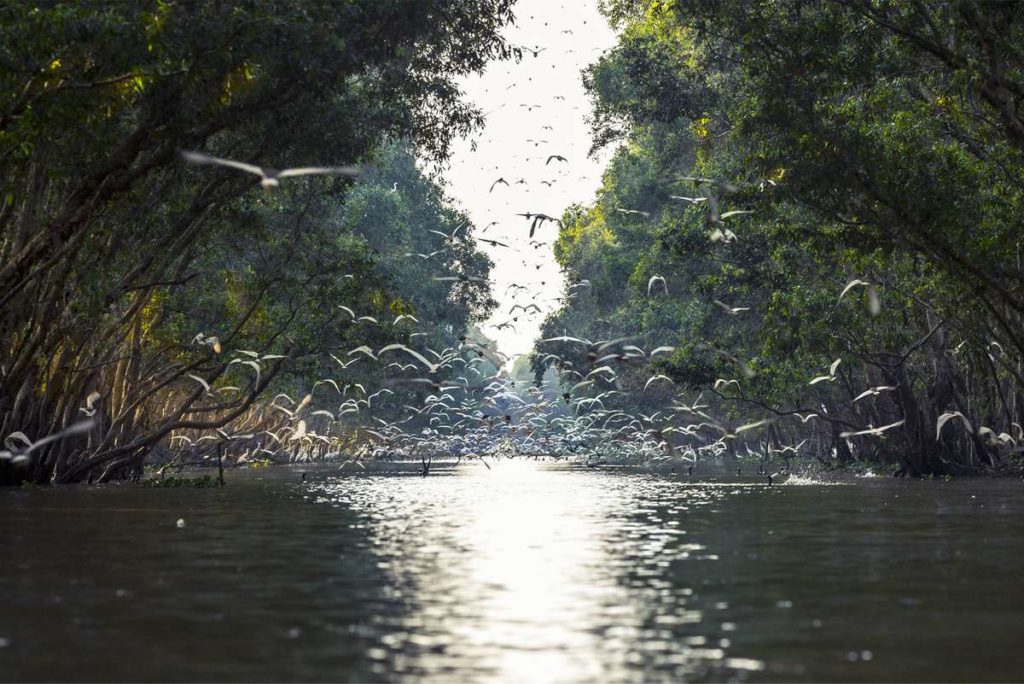What is Tram Chim National Park?
Location & Landscape
Tram Chim National Park is located in Tam Nong District, Dong Thap Province, about 40 km from Cao Lanh and 150 km from Ho Chi Minh City. It lies in the Plain of Reeds (Dong Thap Muoi), a flat and low-lying part of the Mekong Delta. The park covers around 7,600 hectares, making it one of the largest protected wetland areas in southern Vietnam.
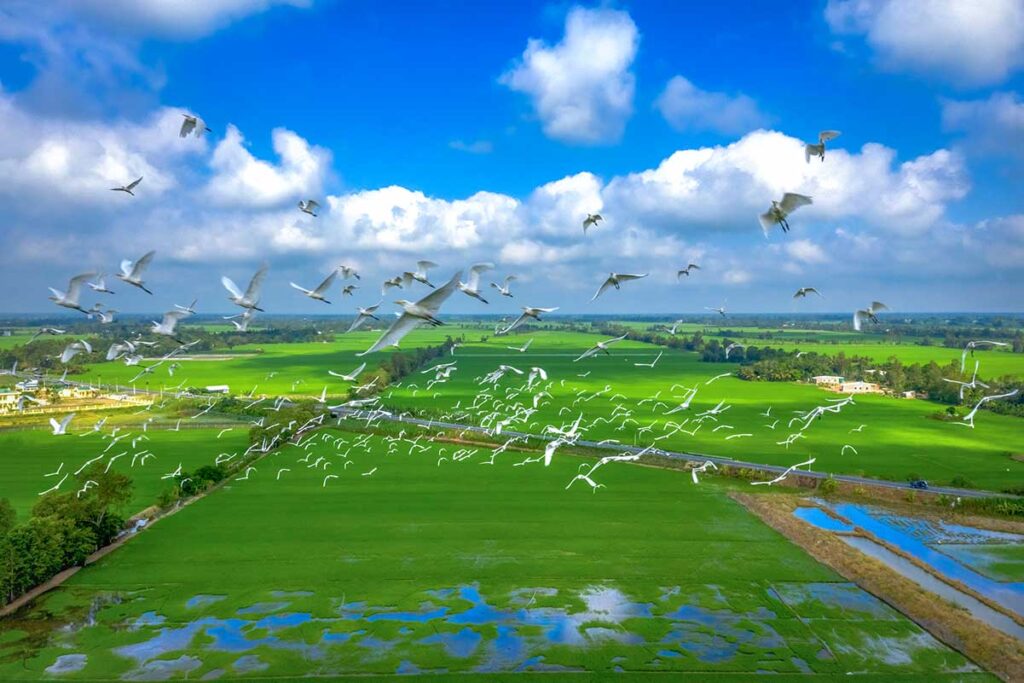
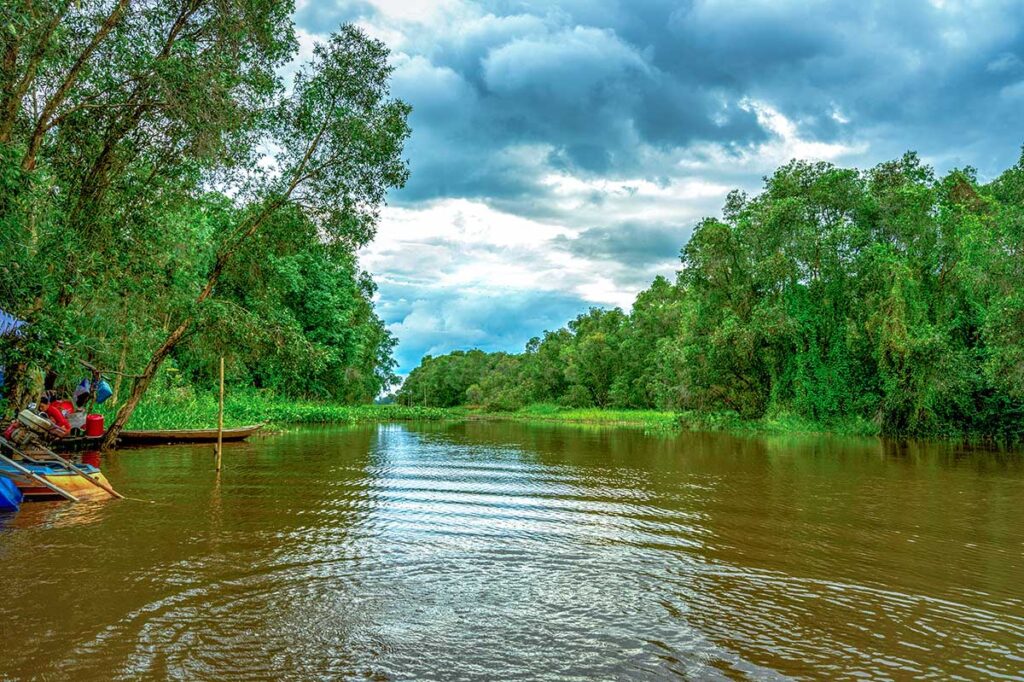
What makes the landscape unique is its seasonal flooding. Each year, from around September to December, the water level rises by 2–4 meters, turning the park into a maze of canals, submerged grasslands, and lotus-filled lagoons. During the dry months, water recedes, exposing grasslands where cranes and other birds forage. This cycle creates very different experiences depending on when you visit.
Ecosystem & Vegetation
Tram Chim is one of Vietnam’s few remaining examples of the natural floodplain ecosystem that once covered much of the Mekong Delta. The park is a mix of habitats: Melaleuca forest (a type of water-tolerant tree), open swamp, lotus and water lily ponds, and grasslands dominated by wild rice.
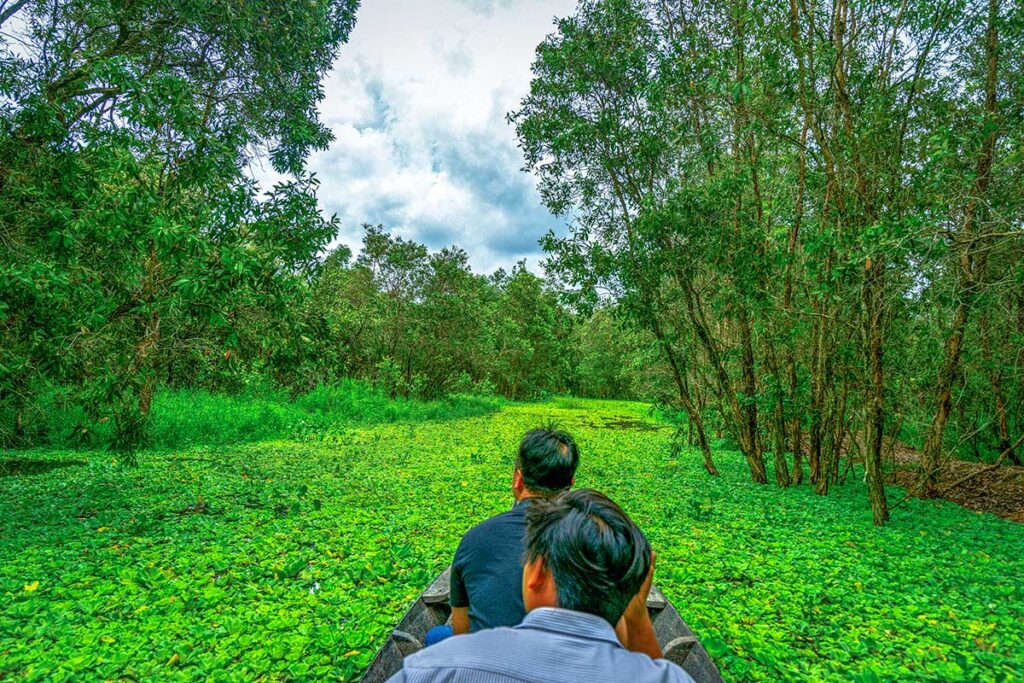
Since the 1980s, the park has been managed with an extensive system of dikes and canals. This allows rangers to control water levels across five zones, protecting habitats and supporting both conservation and local livelihoods. Although this intervention has changed the natural flooding pattern, it also helps maintain the conditions needed for certain plant and bird species to survive.
Birds & Wildlife
Tram Chim is officially recognized as a Ramsar site—a wetland of international importance—and is often called the “kingdom of birds” in the Mekong Delta. More than 230 bird species have been recorded here, which is about a quarter of all bird species in Vietnam.
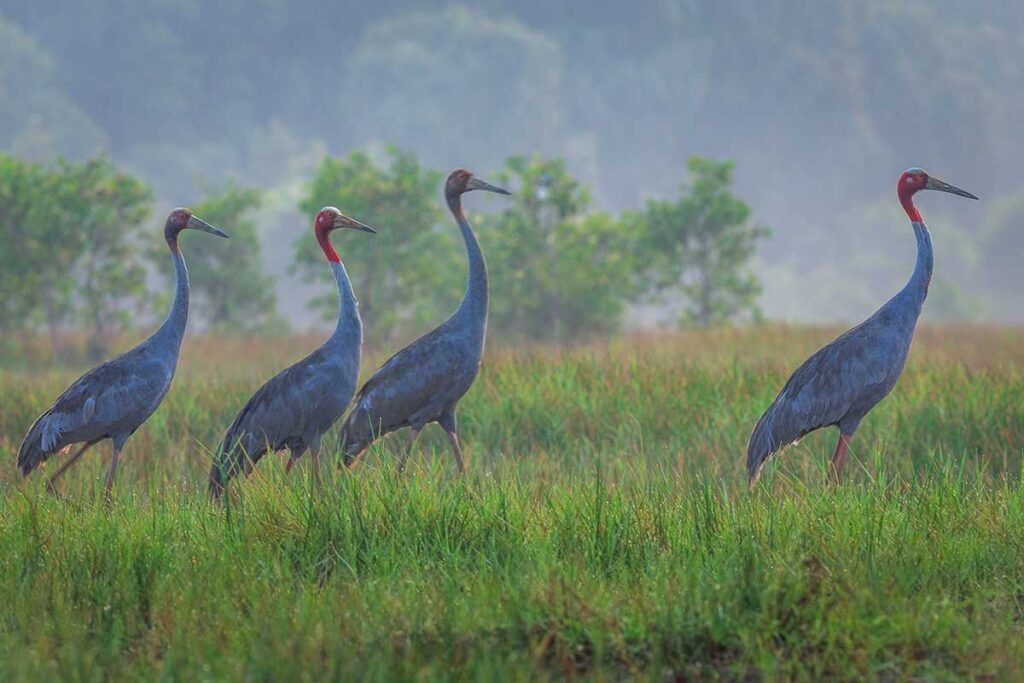
The most famous resident is the red-crowned crane, a globally threatened species that appears during the dry season. Other notable birds include storks, darters, pelicans, and various species of ducks and herons. Birdlife is highly seasonal—sometimes flocks number in the hundreds, while at other times sightings are limited.
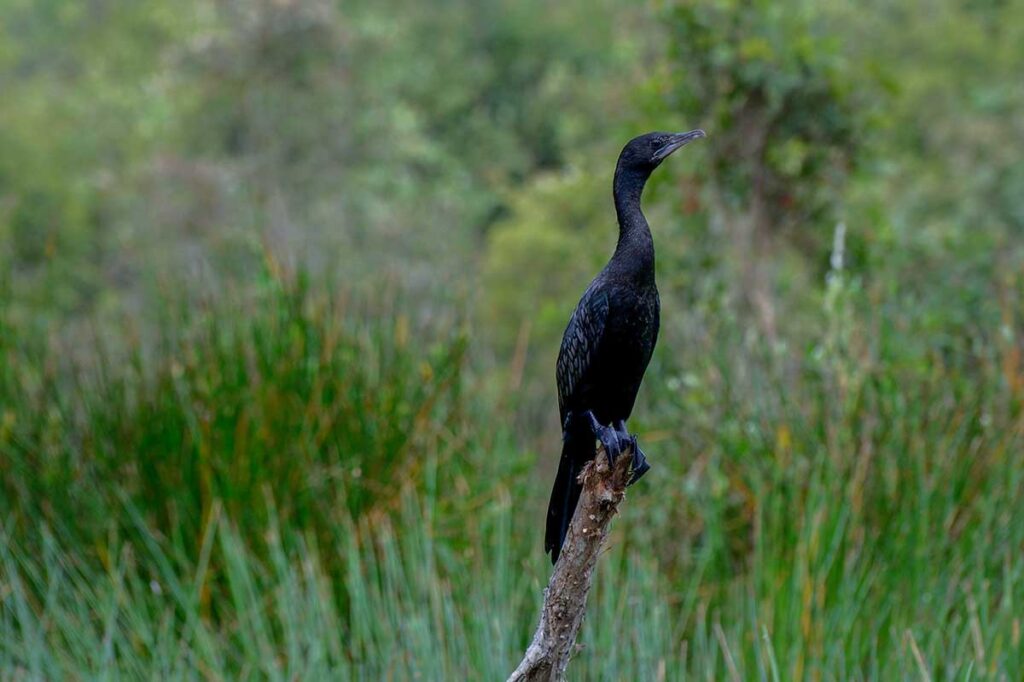
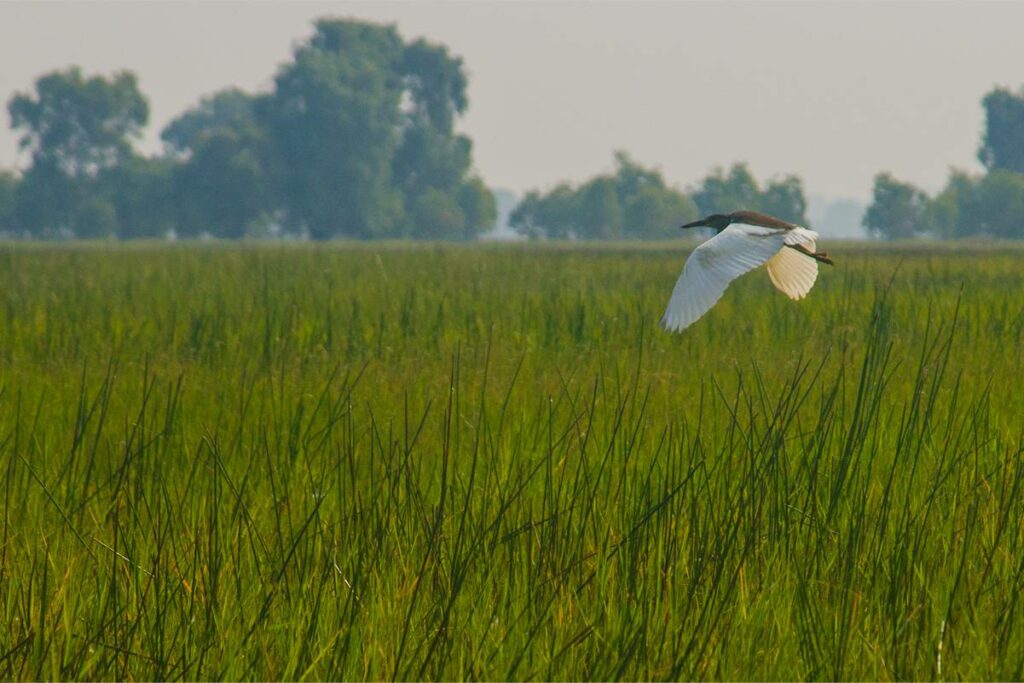
Beyond birds, the wetlands are also home to over 100 vertebrates, dozens of fish species, and reptiles like snakes and turtles. Wildlife spotting here is not guaranteed, but the park’s diversity and the peaceful wetland setting are what make it special.
Highlights of visiting Tram Chim National Park
1. Boat trips
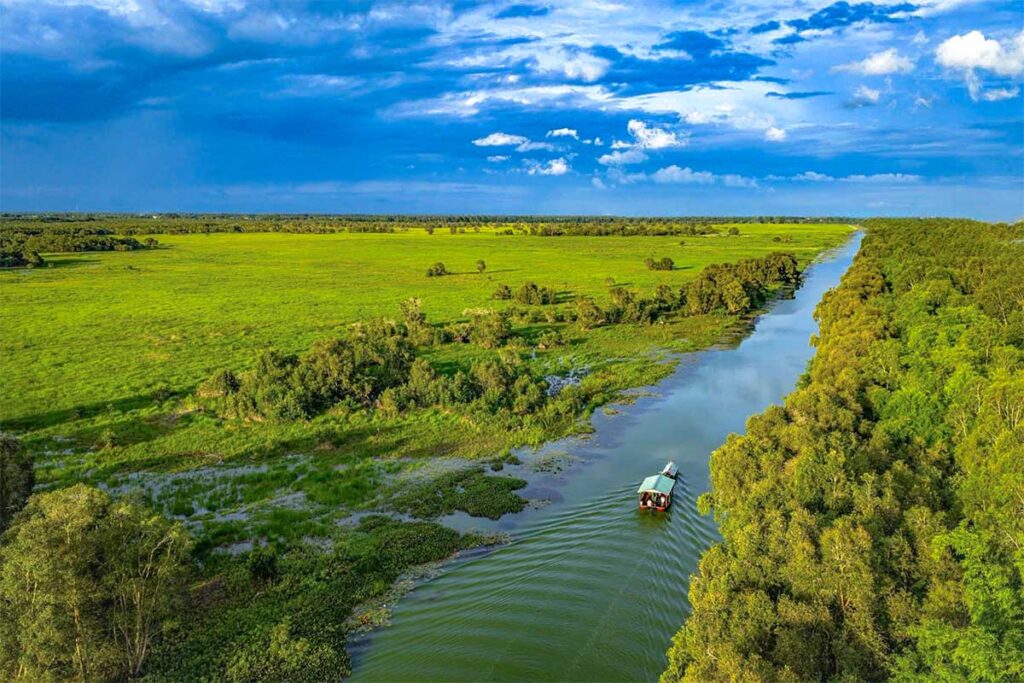
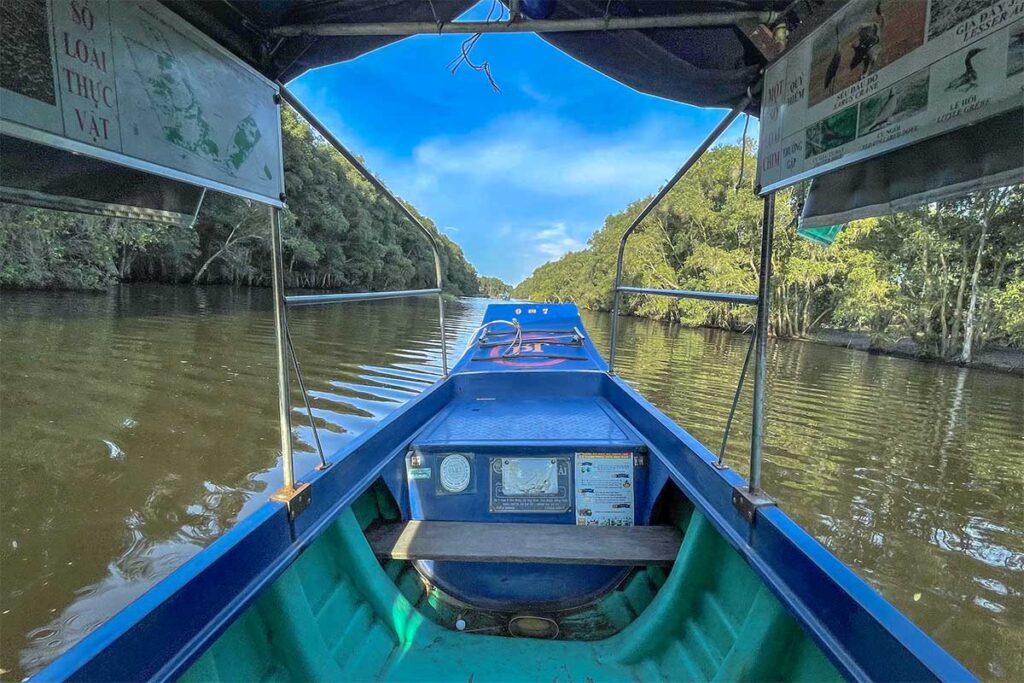
A boat ride is the main way to explore Tram Chim. The waterways wind through lotus fields, Melaleuca forest, and grasslands, giving you a close look at the park’s wetlands and its birdlife. Boats are typically small and relatively quiet, though some use motors which can disturb the atmosphere a little.
- Group size: up to 10 people per boat.
- Food options: You can bring your own food, or in some cases arrange a simple lunch on board. Meals usually feature local specialties like grilled snakehead fish wrapped in lotus leaves.
Nang Ong Route (12 km)
The shorter option, covering about 12 km, costs around 700,000 VND per boat. It usually takes 1–1.5 hours and gives a good overview of the park. This route is better if you’re limited on time or just want a taste of the wetlands without committing to a long trip.
Ca Na Route (21 km)
The longer option, about 21 km, costs around 1,000,000 VND per boat and can take 2–3 hours. The scenery is more varied, and you have a higher chance of spotting different bird species and landscapes. If you want the full experience of Tram Chim, this is the more rewarding choice.
2. Birdwatching
Tram Chim is often called the “kingdom of birds” in the Mekong Delta, and birdwatching is one of its main draws. While sightings depend on the season, the park provides a few facilities that make the experience easier:
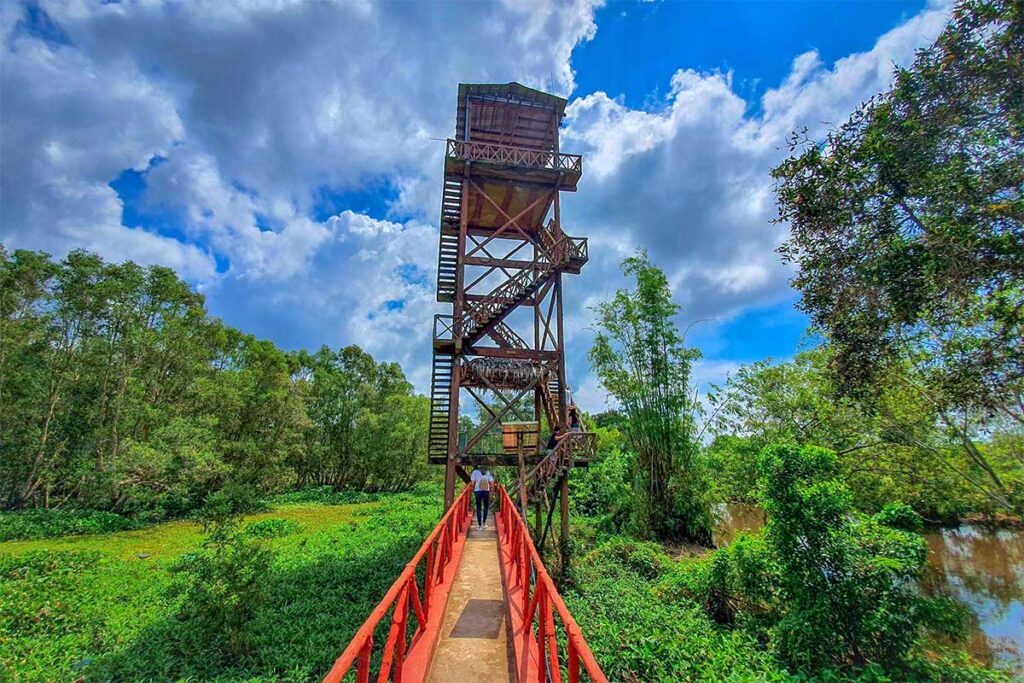
Observation decks: Raised platforms that overlook the wetlands, useful for scanning with binoculars.
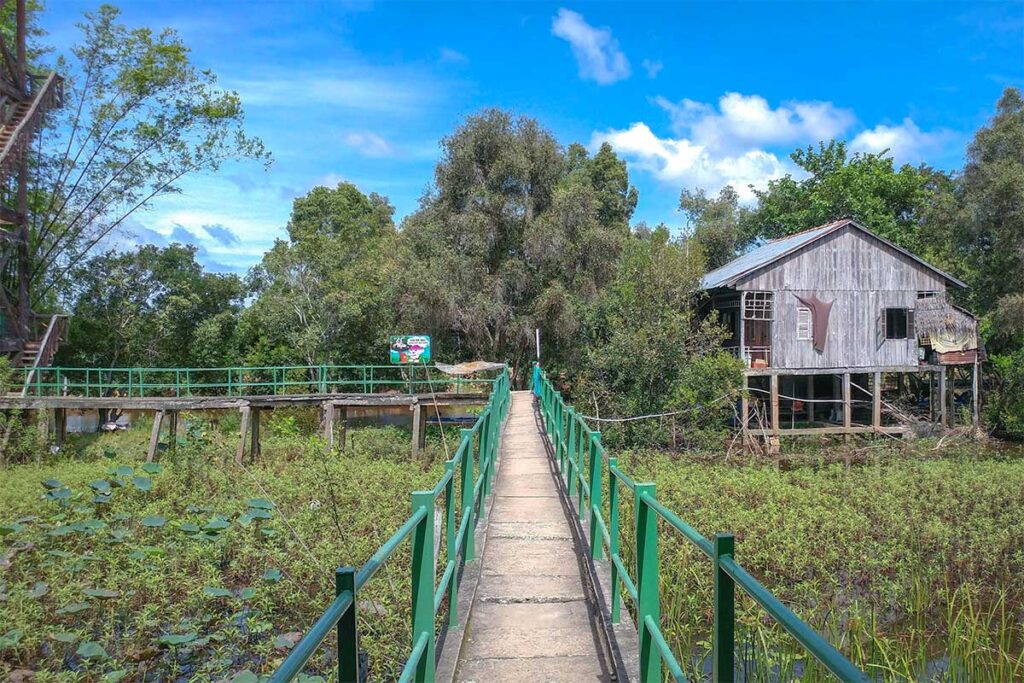
Walking paths: Short trails where you can sometimes spot birds without needing a boat.
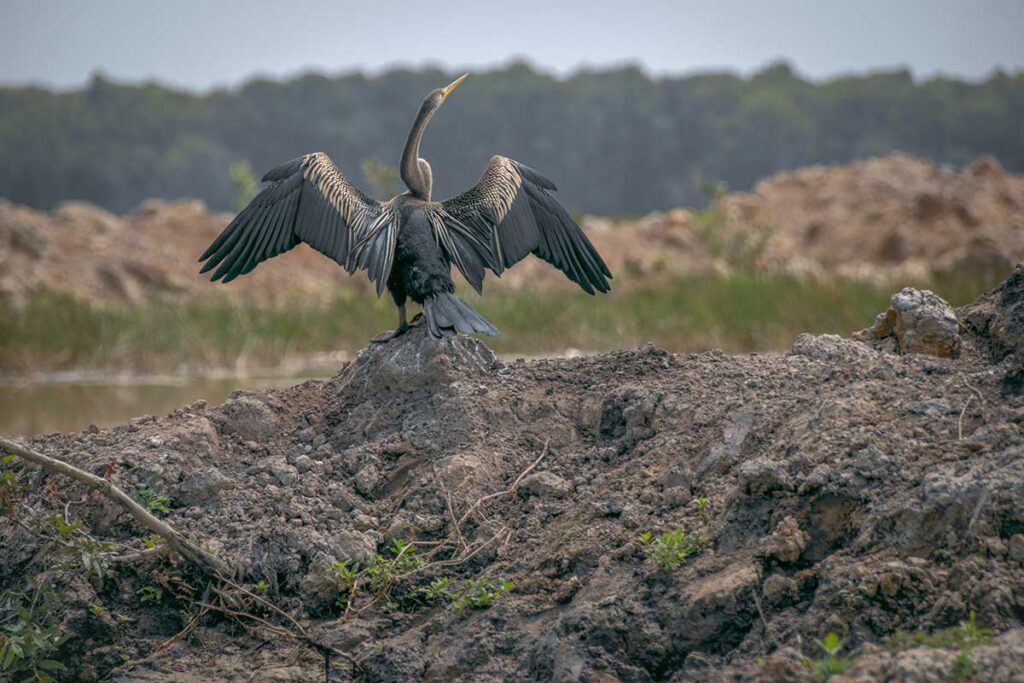
From the boat: The most common way to birdwatch, as birds often feed along the waterways.
Tip: Bring binoculars or a camera with a zoom lens. Early morning and late afternoon tend to be the most active times of day, even outside peak migration or breeding seasons.
3. Local activities
Beyond sightseeing, Tram Chim offers simple activities that give you a feel for how people live with the wetlands. These are usually included as add-ons during boat tours or arranged through local guides.
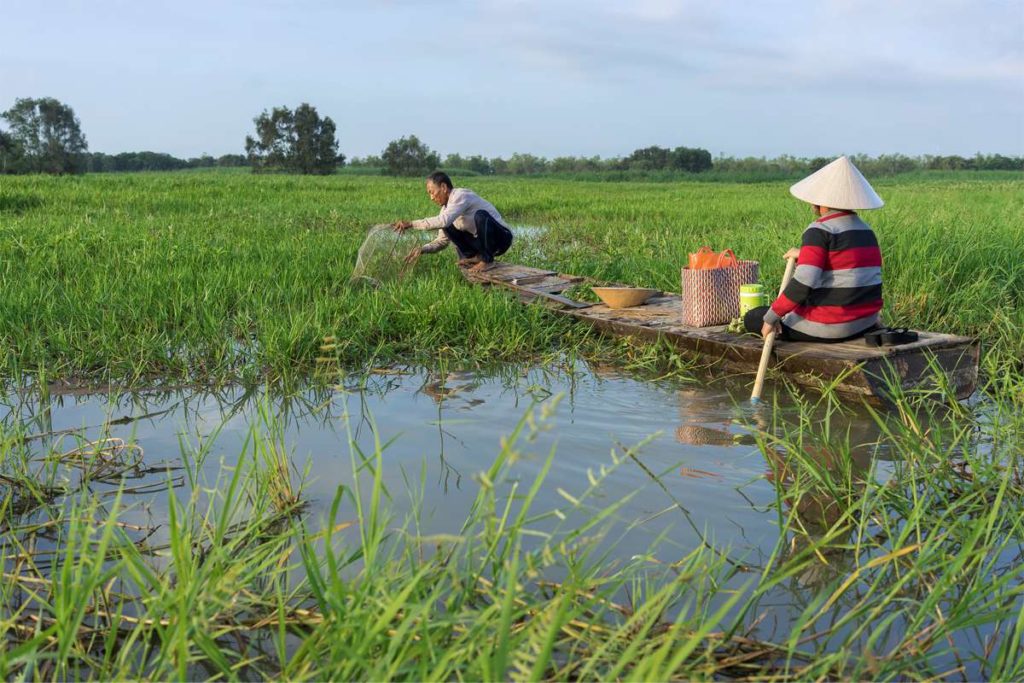
- Fishing – Try casting a net or using a bamboo rod, a common method locals use in the flood season. Whatever you catch can sometimes be cooked for you on the spot.
- Harvesting wild rice – Known locally as “ghost rice,” this grain grows naturally with rising floodwaters. Collecting it by hand is both an activity and a glimpse into how rural communities survive seasonal floods.
- Flood-season village life – In high water months, some tours let you try rowing a small three-leaf boat, setting fish traps, or even helping with the unusual but traditional task of field-mouse hunting.
These activities are quite simple, but they give context to the landscapes you’re exploring and show the close link between nature and local livelihoods.
4. Other attractions in the park
While the natural scenery is the main reason to come, Tram Chim also has a few small attractions that can add variety if you’re spending longer in the park:
- Bird Egg & Freshwater Fish Display House – A small museum-style exhibit showing preserved specimens, useful for understanding the park’s biodiversity.
- Cinema Room – Occasionally used for short educational films about Tram Chim and the Mekong wetlands.
- Red-Crowned Crane Model – A symbolic statue and photo spot representing the park’s most iconic species.
- Rescue & Education Center – A modest facility where injured birds are treated and released, with a focus on conservation education.
These features aren’t must-sees, but they provide context if you want to learn more about the park’s wildlife and conservation role.
Best time to visit Tram Chim National Park
Why timing matters
Tram Chim is not the kind of place that looks the same year-round. The park changes dramatically between the wet season, when the floodwaters turn it into a maze of waterways and lotus fields, and the dry season, when grasslands emerge and rare cranes return. Choosing when to visit shapes what you’ll see and do, from flowers and flooded forests to specific bird species.
Wet season (Jul–Dec)
From July to December, Tram Chim is at its most watery. By September, floodwaters rise to 2–4 meters, covering the grasslands and filling the park with countless ponds and streams. This is the best time for boat trips, as you can drift through lotus and water lily fields, cajeput forest, and open wetlands.
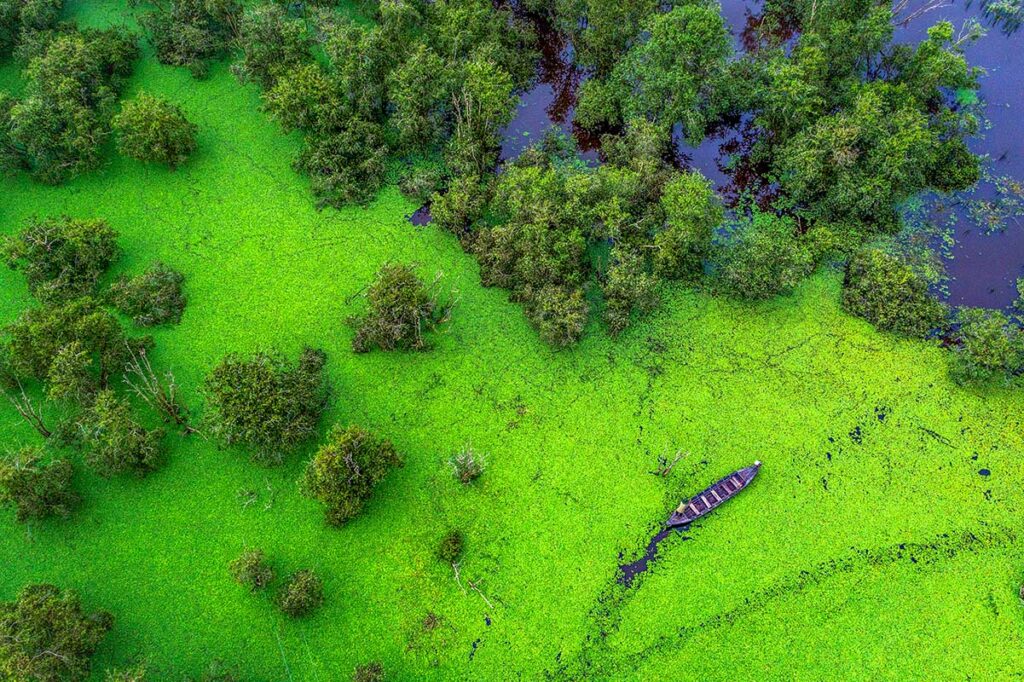
The abundance of water also draws in large numbers of birds that feed and nest in the flooded landscape. Flocks of storks, herons, and ducks are more visible, making birdwatching from a boat especially rewarding.
This season also brings vibrant colors from flowers. Lotus and water lilies are at their peak, and the park feels lush and alive. If you’re after the most scenic views, the flood season is the highlight.
Dry season (Jan–Jun)
In the dry months, water levels drop and grasslands begin to emerge. This is the only time to see red-crowned cranes, usually between February and May, when they forage in open meadows. These tall, elegant birds are globally threatened and considered the symbol of Tram Chim, though spotting them is never guaranteed.
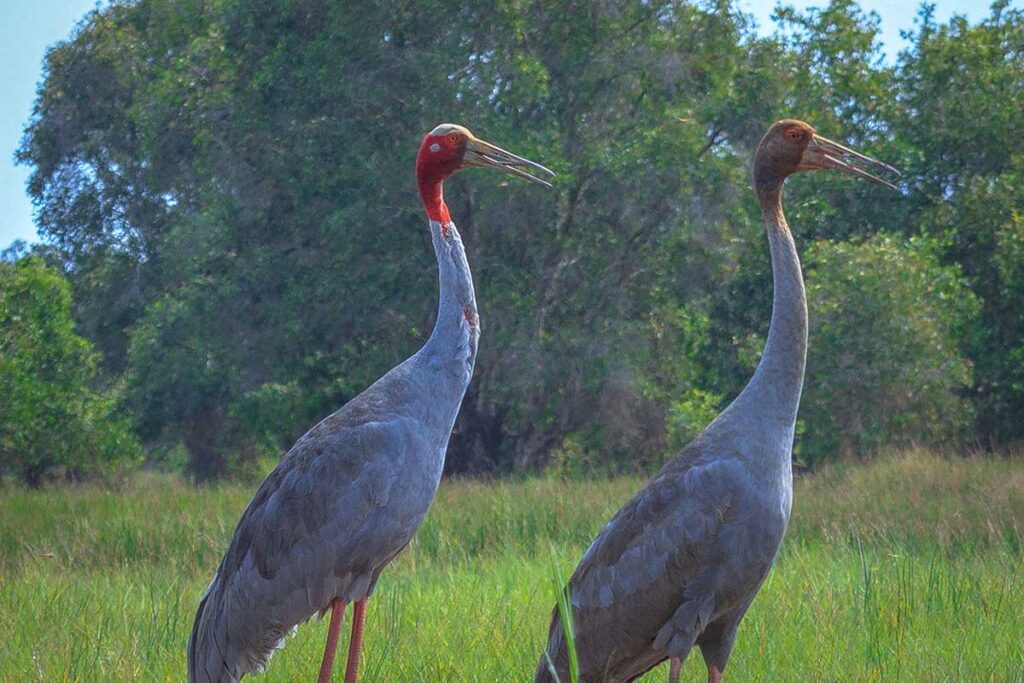
The dry season also brings a different kind of floral display. Two rare species bloom during this time:
- Yellow-headed Anthurium (Jan–Apr), creating carpets of yellow across the wetlands.
- Purple Anthurium (Feb–Mar), forming purple strips along canals in the Melaleuca forest.
These flowers are not as well-known as the lotus but add a unique touch if you come in the right months.
Best time of day
No matter the season, the early morning and late afternoon are the best times to be in the park. Birds are more active, the light is softer for photography, and the atmosphere is quieter. If you’re hoping to see large flocks take off or return to their roosting grounds, aim to start around sunrise or just before sunset.
How to get to Tram Chim National Park
Nearest cities & towns
- Cao Lanh (40 km / ~55 min)
Cao Lanh is the provincial capital of Dong Thap and the closest city to Tram Chim. It’s not a particularly scenic destination in itself, but it can be a convenient base. It sits roughly midway between Sa Dec and Long Xuyen, making it useful for planning a wider Mekong Delta trip. From Ho Chi Minh City, you can reach Cao Lanh by bus in about 3.5–4.5 hours. - Chau Doc (60 km / ~2 hrs)
Chau Doc, in neighboring An Giang Province, is a much more interesting destination, with Sam Mountain, Cham villages, temples, and floating fish farms. Many travelers already include Chau Doc in their Delta itinerary, so visiting Tram Chim from here makes sense. The drive takes about two hours, and it can be combined with other nature sites like Tra Su Cajuput Forest. Buses and private transfers from Ho Chi Minh City to Chau Doc are common. - Long Xuyen (80 km / ~2 hrs)
Long Xuyen is a lively local city with an authentic floating market—less touristy than the markets around Can Tho. It’s a good stop if you want a more local experience, though not as rich in sights as Chau Doc. From Long Xuyen, the trip to Tram Chim is straightforward, usually around two hours by car. Ho Chi Minh City–Long Xuyen buses are frequent and take about 5–6 hours.
Getting to the park
Once you’re in one of the nearby cities, there are several ways to reach Tram Chim:
- Private car with driver
The easiest and most flexible option. You can arrange a fixed price for a return trip, and the driver can wait while you explore or combine Tram Chim with nearby towns. This is also the best choice if you want to design a broader Delta itinerary without worrying about logistics. - Motorbike rental
Renting a motorbike costs around 150,000–200,000 VND per day. Roads to Tram Chim are generally quiet and easy to navigate with GPS, making this a doable option if you’re confident riding. Always bring a valid license and travel insurance that covers motorbikes. - Motorbike driver (xe ôm)
If you don’t want to drive yourself, a local driver can take you there and back on the back of their bike. It’s cheaper than a car, though less comfortable for longer rides. - Public transport
From Ho Chi Minh City, some buses run directly to Tam Nong or Tram Chim town, dropping you close to the park entrance. From Cao Lanh, local buses or shared minibuses (xe khách) also connect to Tam Nong District, usually taking about an hour. While the cheapest option, it requires some flexibility with schedules and a bit of patience.
Practical visitor information & Tips
Opening Hours & Fees
The park is open daily from 7:00 to 17:00. Entrance costs around 20,000 VND per person, with children under 1.4 meters often admitted free. Boat tours are priced separately depending on the route, starting from about 700,000 VND per boat (for up to 10 people). If you’re visiting mainly for birdwatching, keep in mind that tickets are not sold late in the afternoon for safety reasons, even though that’s a prime time for bird activity.
Facilities
Tram Chim is not heavily developed for tourism, but it has a few basic services:
- Visitor center near the entrance, where you can buy tickets and get information.
- Restrooms and some shaded areas for waiting.
- Food stalls and small restaurants around the pier, serving simple meals and drinks.
- Electric shuttles to transfer visitors from the entrance to the boat dock, as motorbikes are not allowed inside.
Facilities are practical but limited—don’t expect full-scale restaurants or cafes inside the park.
What to bring
Packing a few essentials will make your visit more comfortable:
- Binoculars or a zoom lens if birdwatching is your main goal.
- Neutral-colored clothing to blend in better with the environment.
- Mosquito repellent, especially in the wet season.
- Water and light snacks, since food inside the park is limited.
- Hat and sunscreen, as many boat rides are exposed to the sun.
Tips for Visiting
- Boat choice matters: Some tours use noisy motorboats, which can disturb both the peace and the birds. If possible, ask for a slower or quieter option.
- Language barriers: Most guides speak little or no English. A local guide can be helpful if arranged in advance, otherwise don’t expect much interpretation on the spot.
- Clothing: Avoid bright colors if you’re serious about birdwatching, as they can make birds more cautious.
- Respect nature: Bring your trash out, keep noise down, and avoid getting too close to nesting sites.
- Timing: Arrive early if you want to make the most of birdwatching hours; late visitors often miss the best activity.
Nearby sights to combine a visit
Tram Chim is fairly remote, and there aren’t many major attractions right next door. If you’re making the trip, it’s usually best to combine the park with other places in Dong Thap or neighboring An Giang Province to round out your itinerary.
- Rural Dong Thap landscapes – The surrounding countryside is classic Mekong Delta scenery, with endless rice fields, small pagodas, and low-key local markets. It’s pleasant to explore by motorbike or car, though it’s more about atmosphere than big-name sights.
- From Chau Doc (about 2 hrs away) – This is the most rewarding hub to pair with Tram Chim. Chau Doc has cultural highlights like Sam Mountain with its pagodas and viewpoints, the floating fish farms and villages on the river, and Cham villages with mosques and stilt houses. You can also add nature stops like the Tra Su Cajuput Forest.
- From Long Xuyen (about 2 hrs away) – Long Xuyen is best known for its authentic floating market, which is busy early in the morning and not heavily touristy. The surrounding countryside has peaceful canals and farms that can be explored on small boat trips. It’s less cultural than Chau Doc but more local in feel.
Is Tram Chim National Park worth visiting?
Tram Chim is worth visiting if you enjoy birdwatching, wetlands, and quiet natural scenery. The park’s flooded landscapes, lotus fields, and seasonal birdlife are unique in Vietnam, and drifting along its waterways can be very peaceful.
That said, it’s not a place for everyone. If you expect to see large animals or dramatic landscapes, you may find it underwhelming. Bird sightings also depend heavily on the season—sometimes you’ll see flocks in the hundreds, while at other times only a handful. Facilities are basic, and English-speaking guides are limited.
For most travelers, Tram Chim works best as part of a wider Mekong Delta or An Giang trip, combined with places like Chau Doc, Long Xuyen, or Tra Su Forest. On its own, it may feel a little too remote and simple, but within a broader itinerary it adds a distinctive wetland experience.
